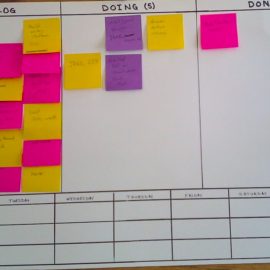

This article is an excerpt from the Shortform book guide to "Scrum" by Jeff Sutherland. Shortform has the world's best summaries and analyses of books you should be reading.
Like this article? Sign up for a free trial here .
Do you have trouble maximizing time at your workplace? How can the Scrum Sprint cycle help your team use their time more efficiently?
Sprints are fixed lengths of time, usually one or two weeks, in which the team works on a particular task or tasks. Scrum Sprints are where the work gets done, where value is created, and where people turn ideas into reality.
Here’s a look at the benefits of the Scrum Sprint cycle.
How Sprints Help Maximize Time
Time is limited, and one of the biggest challenges of a successful business is figuring out how to maximize it. The Scrum framework is designed to maximize time by utilizing Sprints. Sprints help the team build things quickly, get constant feedback, and adjust accordingly.
Deliver Value Quickly
Jeff Sutherland, the author of Scrum, refers to a rule in product development that is proven time and time again: “80 percent of the value is in 20 percent of the features.” This means that in almost any product, the majority of the value lies in only a fifth of the components. The goal of Scrum is to build that 20 percent first. To do this, the first item completed in a Sprint should be something that generates revenue immediately, if possible. The idea is to deliver something of value to the customer in the shortest amount of time, even if it’s only a tiny bit of value.
(Shortform note: The Pareto Principle, or the 80/20 rule, is named after Italian economist Vilfredo Pareto, who noticed that 80% of land in Italy was owned by 20% of the population. The Pareto Principle can be applied to many areas of business and finance, as well as on an individual level. For example, if 80% of customers account for 20% of a company’s sales, it will be helpful to focus on those customers. If you notice 80% of your work production comes from 20% of your time, you can try to change how you work to maximize your time.)
Multitasking and Context Switching
To help deliver value quickly, a Scrum team should focus on doing one task at a time—decide what is the most crucial task and focus on it and nothing else. Sutherland argues that multitasking is a huge misuse of time and energy. Although many people think they are good at multitasking, it’s actually impossible to do it efficiently.
This is because our brains only have the ability to focus on one thing at a time. When trying to juggle multiple tasks at once, a lot of time is wasted as your brain tries to switch from one thing to another. When working on five projects, for example, a whopping 75% of the time will be lost to your brain’s attempts to reorient itself each time you change tasks.
Scrum’s solution to this is simple and obvious: Work on one thing at a time. A team can work much quicker if they prioritize tasks and finish them one at a time. Sutherland argues that if a team finishes three projects sequentially, they will finish in almost half the time as a team that tries to do them all at once.
| Tips for Avoiding Multitasking Other experts likewise note the importance of maintaining focus on one task at a time. Chris Bailey’s Hyperfocus argues that the key to productivity is not managing your time but managing your attention. To hyperfocus is to focus on a single task at a time. Bailey gives five steps to help you hyperfocus: 1. Plan when and for how long you will hyperfocus: Hyperfocus works best as a daily habit, so pick a duration of time you’re comfortable with based on your schedule, energy level, and tasks you’re working on. As you get accustomed to hyperfocusing, you will be able to do it for longer amounts of time. 2. Choose what to focus on: Hyperfocus is most helpful when we choose the right tasks. Choose tasks that will have a meaningful impact and it will help you stay focused. 3. Limit and manage distractions: Distractions feel good. When you give in to a distraction, your brain releases dopamine as you shift focus to something new. 5. Use mindfulness and meditation: Mindfulness and meditation help increase your working memory, which helps you focus on more complex tasks for longer. To meditate, focus on a single thing, like your own breathing, for an extended period of time. To practice mindfulness, pay attention to every external stimulus as you work on simple tasks, like folding laundry. 6. Find a balance between challenge and ease: To keep your mind from wandering, choose tasks that are appropriate for your skill level. Your mind is more likely to wander if you’re bored or stressed. Boredom may come from a task being too easy, while stress may come from a task being too difficult. Find that sweet spot of a high-level task that isn’t too simple or complex. |
Feedback
Scrum Sprints allow you to receive constant feedback on the product as it’s being built. Without consistent feedback, the team could be heading in the wrong direction and not realize it, wasting a lot of time and energy. But with consistent feedback, not only will a team be well-positioned to improve their work process, they’ll be able to adapt to changing market conditions.
The Scrum Sprint cycle encourages three different kinds of feedback:
- Peer-to-peer feedback: The Developers are in constant communication with each other, sharing information and ideas during the Daily Meetings and as they work closely together throughout the Sprint.
- Management-to-developer feedback: As the Product Manager and Scrum Coach attend the Sprint demonstrations and Sprint reflections, they can give the Developers feedback from management.
- Customer-to-team feedback: The Product Manager’s job is to always have the customer’s interests in mind, and to communicate that information to the team. During the Sprint demonstration, the Developers receive direct feedback from potential customers.
Because of the regular feedback embedded into the system, the team is able to adapt and pivot at any point. No time is wasted working on something that brings no value to the project.
| Thanks for the Feedback Sutherland’s emphasis on the importance of incorporating feedback into a project assumes that the person receiving feedback will be receptive to it. However, other management experts note that people are often resistant to hearing criticism, and they offer tips on how to overcome that resistance. In Thanks for the Feedback, Douglas Stone and Sheila Heen give advice on how to be a better receiver of feedback. First, you should understand the main reason most people are bad at receiving feedback: Feedback triggers emotional reactions that cloud our judgment. Feedback causes three types of emotional triggers. The first, truth triggers, occur when we feel the feedback is wrong or unfair. Relationship triggers occur when we find fault with the feedback giver instead of the feedback. Identity triggers occur when feedback threatens our sense of self. Stone and Heen also explain ways to promote feedback at an organizational level. The leadership of a company should push for a culture of learning and make sure employees want to improve and know tools to help receive feedback. They should also set an example and give employees a chance to voice their opinions. The feedback receivers should be aware of their own emotional triggers and be proactive in seeking out advice. |
Fix Mistakes Promptly
Humans aren’t perfect. Missteps and miscalculations will always occur. Sutherland thus cautions that as you give and receive feedback, you should root out errors and problems as quickly as possible, and when you do, take immediate action.
Sutherland argues that doing this helps in two major ways:
- It saves time: Fixing mistakes as soon as they are exposed can save you countless hours. For example, it’s easier to address a single customer complaint before other customers have noticed, or you may end up trying to address a series of poor customer reviews as well.
- It improves quality: As you learn to fix mistakes quickly, you also learn how to work more efficiently. The process constantly improves. Instead of going back and fixing an error later, you fix it immediately and know how to avoid that mistake in the future.
Try to get it right the first time, and if you don’t, correct it quickly.
| Mistake Tolerance Sutherland discusses how the Scrum framework helps fix mistakes quickly, but experts also note that, in the business world, mistakes aren’t something to be feared. Many companies resist making mistakes, but making mistakes—and learning from them—is a vital part of success and innovation. By learning to see mistakes not as failures, but as opportunities to grow, you’ll become a more prosperous and happy person. Here are five ways to increase your mistake tolerance: 1. Embrace trial-and-error 2. Admit your mistakes 3. Turn mistakes into learning opportunities 4. Be kind to yourself when you make a mistake 5. Take risks While the Scrum framework tries to do things right the first time, the crucial aspect of the system is that you minimize the impact of the mistakes you do make, learn from them, and prevent them from happening twice. |
Develop a Rhythm
Sutherland says that rhythm drives the Scrum framework. Because people are naturally inclined to seek patterns, the Scrum framework seeks to organize a rhythm that reinforces positive habits while cutting out the negative ones.
The Scrum Sprint cycle establishes a daily and weekly rhythm to the workflow through daily meetings and Sprint meetings. This helps the team in three major ways:
- Prioritizing tasks: As the team finishes more and more Sprints, they start to get a feel for how long a particular task should take.
- Cyclical worldview: Sprints help establish time as cyclical instead of linear. This repeated pattern of work helps the team produce consistently and sustainably.
- Continuous improvement: As people work together in the same cycles, they learn to work much more efficiently within those cycles.
| Establish Routines in Your Daily Life Finding a rhythm and structure isn’t just important in the business world. Establishing a structure and routine to your daily life is crucial. Having a routine can improve health in a number of ways. Those without a routine are more likely to suffer from increased stress, poor diet, and poor exercise and sleeping habits. Routines help us get things done, but they can also reduce anxiety. We engage in repetitive behaviors to manage stress caused by the unpredictability of the world around us. In other words, routines give us a sense of control. For example, professional athletes may perform the exact same warm-up before every competition. This isn’t necessary to perform the task, but since it makes them feel like they will perform better, it reduces stress and does indeed help them be more successful. In the same way, although Sutherland doesn’t mention it specifically, the rhythm that the Scrum method establishes can help reduce stress for your team by setting predictable checkpoints, milestones, and supports. |

———End of Preview———
Like what you just read? Read the rest of the world's best book summary and analysis of Jeff Sutherland's "Scrum" at Shortform .
Here's what you'll find in our full Scrum summary :
- Why the "Waterfall Method" leads to inefficiency and wasted money
- An explanation of the Scrum method and details on how to implement it
- How to use Sprints to get more work done






